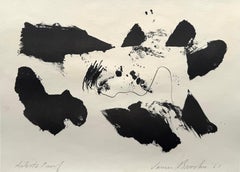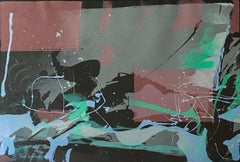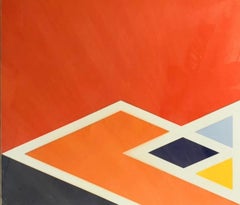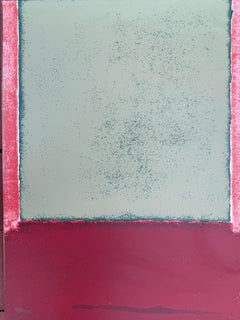Want more images or videos?
Request additional images or videos from the seller
1 of 10
Leon Berkowitz“Dualities #1”Circa 1972
Circa 1972
Price:$975
$1,600List Price
About the Item
- Creator:Leon Berkowitz (1919-1987)
- Creation Year:Circa 1972
- Dimensions:Height: 30 in (76.2 cm)Width: 22 in (55.88 cm)Depth: 1 in (2.54 cm)
- Medium:
- Movement & Style:
- Period:
- Condition:
- Gallery Location:Southampton, NY
- Reference Number:1stDibs: LU14111613512
About the Seller
5.0
Platinum Seller
Premium sellers with a 4.7+ rating and 24-hour response times
Established in 1977
1stDibs seller since 2013
555 sales on 1stDibs
Authenticity Guarantee
In the unlikely event there’s an issue with an item’s authenticity, contact us within 1 year for a full refund. DetailsMoney-Back Guarantee
If your item is not as described, is damaged in transit, or does not arrive, contact us within 7 days for a full refund. Details24-Hour Cancellation
You have a 24-hour grace period in which to reconsider your purchase, with no questions asked.Vetted Professional Sellers
Our world-class sellers must adhere to strict standards for service and quality, maintaining the integrity of our listings.Price-Match Guarantee
If you find that a seller listed the same item for a lower price elsewhere, we’ll match it.Trusted Global Delivery
Our best-in-class carrier network provides specialized shipping options worldwide, including custom delivery.You May Also Like
Organic Mid-Century Floating Shapes in Blue Tones, Monotype Cyanotype on Paper
By Kind of Cyan
Located in Barcelona, ES
Mid-Century Shapes XIII is a captivating cyanotype monotype that draws on the visual language of mid-century abstraction. Featuring fluid, interlocking forms rendered in rich Prussi...
Category
2010s Post-Modern Abstract Prints
Materials
Paper, Lithograph, Monotype
Grand Canyon River, Organic Minimalism, Soft Blue Cyanotype, Abstract Landscape
By Kind of Cyan
Located in Barcelona, ES
This unique cyanotype monotype transforms organic, river-like forms into a serene field of flowing blues. Soft, undulating shapes echo water, canyon horizons, and desert calm, giving...
Category
2010s Post-Modern Abstract Prints
Materials
Paper, Lithograph, Monotype
Delicate Abstract Lithograph with Blue and Orange
Located in Soquel, CA
Delicate Abstract Lithograph with Blue and Orange by American Beat artist Will Peterson (1928-1994.)
This lithograph blends the linework and movement of abstract impressionism with a color field-esque composition. The vibrant orange rectangle in the center of the piece is bracketed by a contrasting cobalt border. The edges of these shapes are softened by delicate linework and areas of hazy lighter blues and whites. Overall, this creates an atmospheric and striking piece.
Lithograph is printed on wove paper which is fixed to a larger piece of handmade paper containing the artists signature and a small embossing found on his other pieces from this time period. This paper is displayed on top of a linen covered board with sturdy wood edges and a plexiglass over over the entire piece.
Will Peterson was born in Chicago in 1928 to German immigrant parents. He contracted Polio when he was in High School and thus spent much of his early years ill. During this time he started working as a cartoonist for his high school’s paper. He started his official art studies at Wilber Wright College in Chicago and later earned a BA and a MA at Michigan State University. Here he studied print making and lithography under John S. deMartelly. He began enjoying artistic success while still in graduate school, exhibiting at the Detroit Art Institute, the Terry Art Institute, the National Print Exhibition, and the Boston Printmakers.
Peterson was drafted into the army in 1952 and thus spent time in Korea and Japan. His time as an educational specialist in Hokkaido was a formative experience for him and his interest in Japanese calligraphy and other arts influenced his later work. Upon returning to the United States, he moved to Oakland, California. He became involved with the beat movement and after founding the Bay Printmakers Society with fellow artist Mel Strawn...
Category
1960s Post-Modern Abstract Prints
Materials
Handmade Paper, Lithograph
$1,800
H 16.38 in W 12.38 in D 1.38 in
Abstract Color Field Lithograph in Pale Blue and Brown
Located in Soquel, CA
Abstract Color Field Lithograph in Pale Blue and Brown by American Beat artist Will Peterson (1928-1994.)
This lithograph blends the linework and movement of abstract impressionism with a color field-esque composition. A long copper-brown rectangle shines through from the bottom layer of the colors. It is then crossed in multiple places by black linework and hatching. Around this shape a pale cornflower blue acts as a frame and crosses the brown shape in the center. The addition of the cool black and blue tones creates a sense of warmth in the underlying shape.
Lithograph is printed on wove paper which is fixed to a larger piece of handmade paper containing the artists signature and a small embossing found on his other pieces from this time period. This paper is displayed on top of a linen covered board with sturdy wood edges and a plexiglass over over the entire piece.
Will Peterson was born in Chicago in 1928 to German immigrant parents. He contracted Polio when he was in High School and thus spent much of his early years ill. During this time he started working as a cartoonist for his high school’s paper. He started his official art studies at Wilber Wright College in Chicago and later earned a BA and a MA at Michigan State University. Here he studied print making and lithography under John S. deMartelly. He began enjoying artistic success while still in graduate school, exhibiting at the Detroit Art Institute, the Terry Art Institute, the National Print Exhibition, and the Boston Printmakers.
Peterson was drafted into the army in 1952 and thus spent time in Korea and Japan. His time as an educational specialist in Hokkaido was a formative experience for him and his interest in Japanese calligraphy and other arts influenced his later work. Upon returning to the United States, he moved to Oakland, California. He became involved with the beat movement and after founding the Bay Printmakers Society with fellow artist Mel Strawn...
Category
1960s Post-Modern Figurative Prints
Materials
Handmade Paper, Lithograph
$1,650
H 16.38 in W 12.38 in D 1.38 in
Delicate Abstract Lithograph in Pale Blues and Greys
Located in Soquel, CA
Delicate Abstract Lithograph in Pale Blues and Greys by American Beat artist Will Peterson (1928-1994.)
This lithograph features a soft warm grey background overlayed with light blue shading and line work. In the bottom center of the piece is a spiky white shape. The colors and shapes are subtle and feel reminiscent of ice.
Lithograph is printed on wove paper which is fixed to a larger piece of handmade paper containing the artists signature and a small embossing found on his other pieces from this time period. This paper is displayed on top of a linen covered board with sturdy wood edges and a plexiglass over over the entire piece.
Will Peterson was born in Chicago in 1928 to German immigrant parents. He contracted Polio when he was in High School and thus spent much of his early years ill. During this time he started working as a cartoonist for his high school’s paper. He started his official art studies at Wilber Wright College in Chicago and later earned a BA and a MA at Michigan State University. Here he studied print making and lithography under John S. deMartelly. He began enjoying artistic success while still in graduate school, exhibiting at the Detroit Art Institute, the Terry Art Institute, the National Print Exhibition, and the Boston Printmakers.
Peterson was drafted into the army in 1952 and thus spent time in Korea and Japan. His time as an educational specialist in Hokkaido was a formative experience for him and his interest in Japanese calligraphy and other arts influenced his later work. Upon returning to the United States, he moved to Oakland, California. He became involved with the beat movement and after founding the Bay Printmakers Society with fellow artist Mel Strawn...
Category
1960s Post-Modern Abstract Prints
Materials
Handmade Paper, Lithograph
$1,475
H 16.38 in W 12.38 in D 1.38 in
Entrebanc 14
Located in Barcelona, BARCELONA
Includes a Certificate of Authenticity
Category
1970s Post-Modern Abstract Prints
Materials
Lithograph
Untitled
Located in Barcelona, BARCELONA
Includes a Certificate of Authenticity
Category
21st Century and Contemporary Post-Modern Abstract Prints
Materials
Lithograph
Entrebanc 7
Located in Barcelona, BARCELONA
Includes a Certificate of Authenticity
Category
1970s Post-Modern Abstract Prints
Materials
Lithograph
Untitled
Located in Barcelona, BARCELONA
Includes a Certificate of Authenticity
Category
Early 2000s Post-Modern Abstract Prints
Materials
Lithograph
Untitled
Located in Barcelona, BARCELONA
Includes a Certificate of Authenticity
Category
Early 2000s Post-Modern Abstract Prints
Materials
Lithograph
More From This Seller
View All“Untitled”
By James Brooks
Located in Southampton, NY
Original black and white abstract lithograph on archival paper by the well known American modernist artist, James Brooks. Signed in pencil by the artist and dated 1961 lower right. ...
Category
1960s Post-Modern Abstract Prints
Materials
Archival Paper, Lithograph
“Shore Sentry”
By Syd Solomon
Located in Southampton, NY
Shore Sentry, is an original color, limited edition lithograph on handmade German black etching paper; printed by Topaz Editions in 1977. Artist proofs 10. Edition size 100. Provenance:: A Sarasota, Florida collector
Signed: Artist signed lower left with edition size
Image size: 22 by 30 inches
Sheet size: 30 by 38 inches
Edition 38/100
Condition: Excellent
Overall framed size: 30.25 by 38.25 inches
Framed under plexiglass in chrome colored metal gallery frame
SYD SOLOMON BIOGRAPHY
Written by Dr. Lisa Peters/Berry Campbell Gallery
“Here, in simple English, is what Syd Solomon does: He meditates. He connects his hand and paintbrush to the deeper, quieter, more mysterious parts of his mind- and he paints pictures of what he sees and feels down there.”
--Kurt Vonnegut Jr. from Palm Sunday, 1981
Syd Solomon was born near Uniontown, Pennsylvania, in 1917. He began painting in high school in Wilkes-Barre, where he was also a star football player. After high school, he worked in advertising and took classes at the Art Institute of Chicago. Before the attack on Pearl Harbor, he joined the war effort and was assigned to the First Camouflage Battalion, the 924th Engineer Aviation Regiment of the US Army. He used his artistic skills to create camouflage instruction manuals utilized throughout the Army. He married Ann Francine Cohen in late 1941. Soon thereafter, in early 1942, the couple moved to Fort Ord in California where he was sent to camouflage the coast to protect it from possible aerial bombings. Sent overseas in 1943, Solomon did aerial reconnaissance over Holland. Solomon was sent to Normandy early in the invasion where his camouflage designs provided protective concealment for the transport of supplies for men who had broken through the enemy line. Solomon was considered one of the best camoufleurs in the Army, receiving among other commendations, five bronze stars. Solomon often remarked that his camouflage experience during World War II influenced his ideas about abstract art. At the end of the War, he attended the École des Beaux-Arts in Paris.
Because Solomon suffered frostbite during the Battle of the Bulge, he could not live in cold climates, so he and Annie chose to settle in Sarasota, Florida, after the War. Sarasota was home to the John and Mable Ringling Museum of Art, and soon Solomon became friends with Arthur Everett “Chick” Austin, Jr., the museum’s first Director. In the late 1940s, Solomon experimented with new synthetic media, the precursors to acrylic paints provided to him by chemist Guy Pascal, who was developing them. Victor D’Amico, the first Director of Education for the Museum of Modern Art, recognized Solomon as the first artist to use acrylic paint. His early experimentation with this medium as well as other media put him at the forefront of technical innovations in his generation. He was also one of the first artists to use aerosol sprays and combined them with resists, an innovation influenced by his camouflage experience.
Solomon’s work began to be acknowledged nationally in 1952. He was included in American Watercolors, Drawings and Prints at the Metropolitan Museum of Art, New York. From 1952–1962, Solomon’s work was discovered by the cognoscenti of the art world, including the Museum of Modern Art Curators, Dorothy C. Miller and Peter Selz, and the Whitney Museum of American Art’s Director, John I. H. Baur. He had his first solo show in New York at the Associated American Artists Gallery in 1955 with “Chick” Austin, Jr. writing the essay for the exhibition. In the summer of 1955, the Solomons visited East Hampton, New York, for the first time at the invitation of fellow artist David Budd. There, Solomon met and befriended many of the artists of the New York School, including Jackson Pollock, Franz Kline, Willem de Kooning, James Brooks, Alfonso Ossorio, and Conrad Marca-Relli. By 1959, and for the next thirty-five years, the Solomons split the year between Sarasota (in the winter and spring) and the Hamptons (in the summer and fall).
In 1959, Solomon began showing regularly in New York City at the Saidenberg Gallery with collector Joseph Hirshhorn buying three paintings from Solomon’s first show. At the same time, his works entered the collections of the Whitney Museum of American Art, the Solomon R. Guggenheim Museum, and the Wadsworth Athenaeum in Hartford, Connecticut, among others. Solomon also began showing at Signa Gallery in East Hampton and at the James David Gallery in Miami run by the renowned art dealer, Dorothy Blau.
In 1961, the Guggenheim Museum’s H. H. Arnason bestowed to him the Silvermine Award at the 13th New England Annual. Additionally, Thomas Hess of ARTnews magazine chose Solomon as one of the ten outstanding painters of the year. At the suggestion of Alfred H. Barr, Jr., the Museum of Modern Art’s Director, the John and Mable Ringling Museum in Sarasota began its contemporary collection by purchasing Solomon’s painting, Silent World, 1961.
Solomon became influential in the Hamptons and in Florida during the 1960s. In late 1964, he created the Institute of Fine Art at the New College in Sarasota. He is credited with bringing many nationally known artists to Florida to teach, including Larry Rivers, Philip Guston, James Brooks, and Conrad Marca-Relli. Later Jimmy Ernst, John Chamberlain, James Rosenquist, and Robert Rauschenberg settled near Solomon in Florida. In East Hampton, the Solomon home was the epicenter of artists and writers who spent time in the Hamptons, including Alfred Leslie, Jim Dine, Ibram Lassaw, Saul Bellow...
Category
1970s Post-Modern Abstract Prints
Materials
Handmade Paper, Lithograph
“Gemini Series Untitled (Red)”
By Larry Zox
Located in Southampton, NY
Original screen print from the Gemini series “Untitled” (Red), 1968 by Larry Zox. Condition is good. Mild toning of the white areas in the screen print. Other colors are still vibra...
Category
1960s Post-Modern Abstract Prints
Materials
Archival Paper, Screen
“Untitled”
By Theodoros Stamos
Located in Southampton, NY
Original screen print on archival paper by Theodorus Stamos. Untitled. Signed in pencil lower left. Edition. 73/75 in pencil lower right. Executed in 1965. Condition is excellent. ...
Category
1960s Post-Modern Abstract Prints
Materials
Archival Paper, Screen
“Untitled” (from the Lezard aux Plumes d’Or series)
By Joan Miró
Located in Southampton, NY
Colored lithograph on archival paper by Joan Miro. Part of the “Lizard with the Golden Feathers series. Signed in pencil “Miro” lower right. “H.C.” lower left. (See details below) ...
Category
1970s Modern Abstract Prints
Materials
Archival Paper, Lithograph
“Untitled”
By Ferdinand Springer
Located in Southampton, NY
Original aquatint etching “Untitled” by the Germans artist, Ferdinand Springer. Signed in lower right margin in pencil by the artist and dated 1951. Condition is excellent. Edition size in pencil in lower left margin 98/200. Sheet size (full) is 115 by 22.75. Image size is 9.75 by 18.75. The artwork is housed in a thin antique silver contemporary frame. Overall framed measurements are 19.5 by 27 inches. Under glass. Provenance: A St. Petersburg, Florida collector.
Ferdinand Springer, painter and printmaker, was born to a German father and a Swiss mother in Berlin on October 1, 1907. After graduating from high school in Potsdam, he studied art history at the University of Zurich. He began painting in 1927 and visited Milan where he met the Italian painters Giorgio Morandi and Carlo Carrà.
Springer moved to Paris in 1928 where he studied with Roger Bissière at the Académie Ranson. In 1932, he learned intaglio techniques at Atelier 17 in Paris and, in 1937, he traveled to New York where he exhibited at the Julian Levy Gallery. During this time he met Alexander Calder and Salvatore Dali...
Category
1950s Modern Abstract Prints
Materials
Archival Paper, Etching, Aquatint
$960 Sale Price
20% Off



